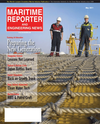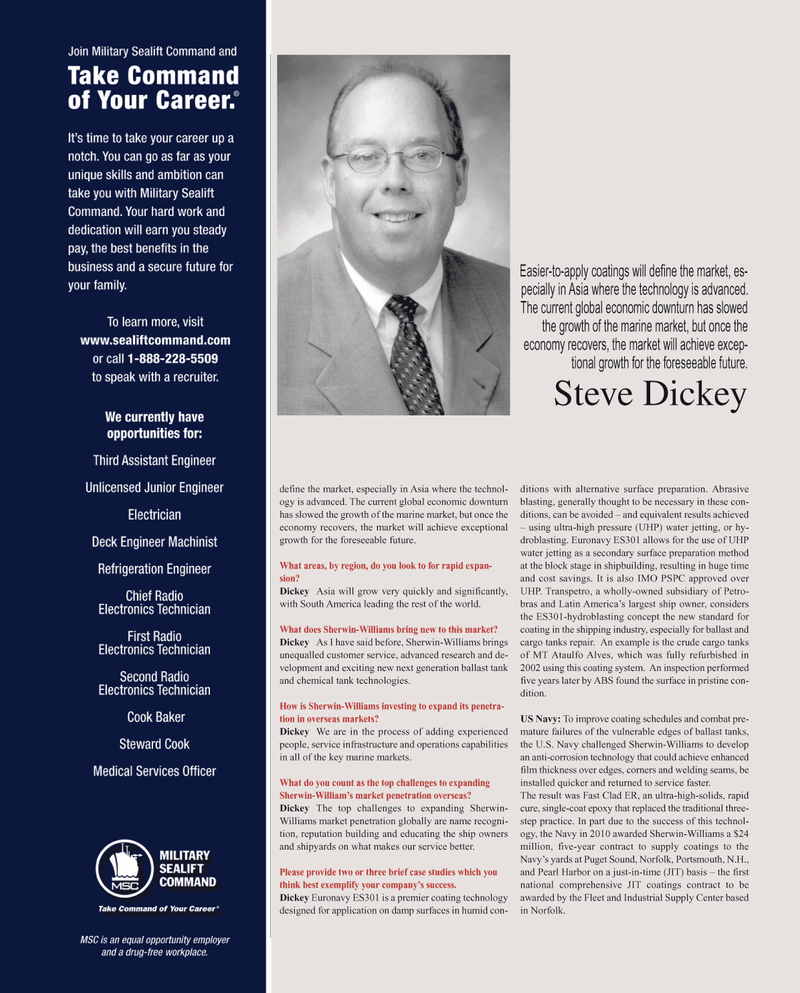
Page 8: of Maritime Reporter Magazine (May 2011)
Training & Education Edition
Read this page in Pdf, Flash or Html5 edition of May 2011 Maritime Reporter Magazine
define the market, especially in Asia where the technol- ogy is advanced. The current global economic downturn has slowed the growth of the marine market, but once the economy recovers, the market will achieve exceptional growth for the foreseeable future.
What areas, by region, do you look to for rapid expan- sion?
Dickey Asia will grow very quickly and significantly, with South America leading the rest of the world.
What does Sherwin-Williams bring new to this market?
Dickey As I have said before, Sherwin-Williams brings unequalled customer service, advanced research and de- velopment and exciting new next generation ballast tank and chemical tank technologies.
How is Sherwin-Williams investing to expand its penetra- tion in overseas markets?
Dickey We are in the process of adding experienced people, service infrastructure and operations capabilities in all of the key marine markets.
What do you count as the top challenges to expanding
Sherwin-William’s market penetration overseas?
Dickey The top challenges to expanding Sherwin-
Williams market penetration globally are name recogni- tion, reputation building and educating the ship owners and shipyards on what makes our service better.
Please provide two or three brief case studies which you think best exemplify your company’s success.
Dickey Euronavy ES301 is a premier coating technology designed for application on damp surfaces in humid con- ditions with alternative surface preparation. Abrasive blasting, generally thought to be necessary in these con- ditions, can be avoided – and equivalent results achieved – using ultra-high pressure (UHP) water jetting, or hy- droblasting. Euronavy ES301 allows for the use of UHP water jetting as a secondary surface preparation method at the block stage in shipbuilding, resulting in huge time and cost savings. It is also IMO PSPC approved over
UHP. Transpetro, a wholly-owned subsidiary of Petro- bras and Latin America’s largest ship owner, considers the ES301-hydroblasting concept the new standard for coating in the shipping industry, especially for ballast and cargo tanks repair. An example is the crude cargo tanks of MT Ataulfo Alves, which was fully refurbished in 2002 using this coating system. An inspection performed five years later by ABS found the surface in pristine con- dition.
US Navy: To improve coating schedules and combat pre- mature failures of the vulnerable edges of ballast tanks, the U.S. Navy challenged Sherwin-Williams to develop an anti-corrosion technology that could achieve enhanced film thickness over edges, corners and welding seams, be installed quicker and returned to service faster.
The result was Fast Clad ER, an ultra-high-solids, rapid cure, single-coat epoxy that replaced the traditional three- step practice. In part due to the success of this technol- ogy, the Navy in 2010 awarded Sherwin-Williams a $24 million, five-year contract to supply coatings to the
Navy’s yards at Puget Sound, Norfolk, Portsmouth, N.H., and Pearl Harbor on a just-in-time (JIT) basis – the first national comprehensive JIT coatings contract to be awarded by the Fleet and Industrial Supply Center based in Norfolk.
Easier-to-apply coatings will define the market, es- pecially in Asia where the technology is advanced.
The current global economic downturn has slowed the growth of the marine market, but once the economy recovers, the market will achieve excep- tional growth for the foreseeable future.
Steve Dickey

 7
7

 9
9
